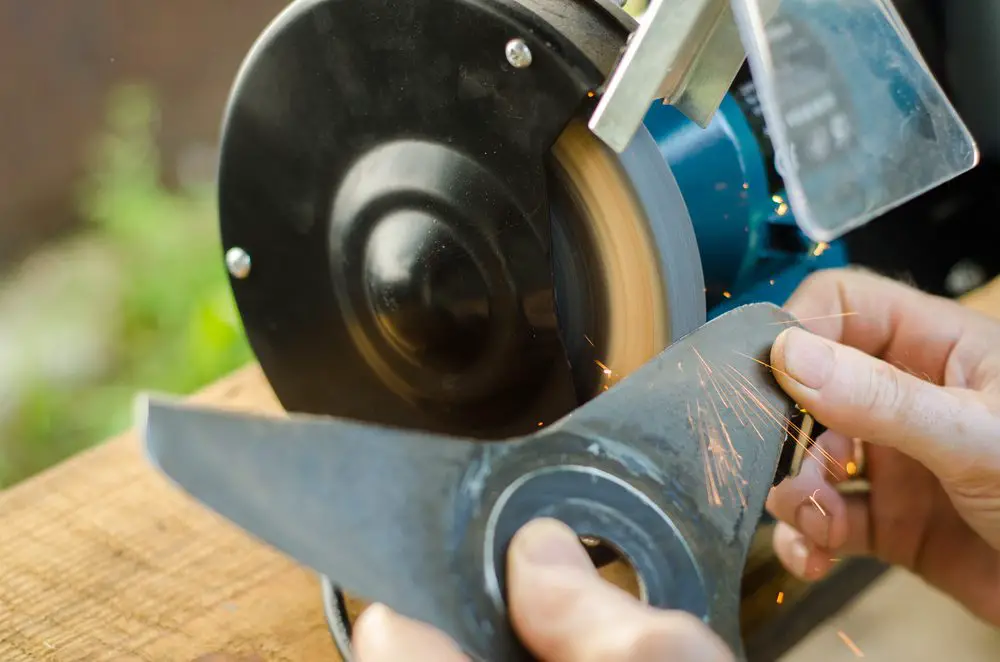Lawnmower blades should be sharpened two or three times during the growing season; at least this is the standard requirement. However, many homeowners hardly sharpen the blades. They wait until it’s too blunt or ripping through the grass. Dull blades create torn tips on the edges of grass, leaving it susceptible to pests and disease.
Sharp blades, on the other hand, make clean cuts leaving it neatly trimmed and healthy. Additionally, they make it easier to use the equipment and require less energy. Here’s a guide to help you sharpen a lawnmower using a bench grinder:
Tools Required
- Bench grinder
- A wrench
- Protective glasses
- A vise
- A pair of welding gloves
- Lubricant
- Plastic balancer
Procedure
Turn the Machine Off
Disconnect the ignition wire from the spark plug, but if you are using a cordless mower, you need to remove the battery pack. It eliminates any chance of the engine igniting when working on the lawnmower.
You Might Like: Bench Grinders for Sharpening Blades
You also need to drain the gas tank, so it doesn’t spill fuel while removing the blades. Alternatively, run the lawnmower until the gas depletes.
Remove the Blades
Tilt the lawnmower to the side to access the bolt securing the blade. Be sure to keep it steady, so it does not fall while removing the blade.
Also, place a short block of wood between inside the surface of the mowing deck and the end of the blade to prevent the blade from turning. Then, use a wrench to unscrew the bolt.
You may find it a little challenging to remove the nut, especially if it has rust. In this case, apply penetrating oil and allow it to rest for 10 minutes and try again.
If the nut still doesn’t budge, slip a metal pipe over the wrench handle to enhance the strength of your grip. Be sure to mark the non-cutting side to make it easy to re-install the blade correctly.
Prepare the Blade for Sharpening
You need to clean the blade as it probably has debris and grass clippings stuck. If it is slightly dirty, use a dry rag to wipe off the dirt, but if it has too much grime, hose it using soap and water. Be sure to dry the blade completely before sharpening it.
Sharpen the Blade
Switch on the bench grinder and angle the blade on the footrest to begin sharpening. A bench grinder is a handy tool for sharpening lawn mower blades as it is fast and effective than other simple methods like filing. Filing is ideal when you want to rid of dings and dents, but it may not be effective when sharpening an incredibly dull blade.
It is essential to wear gloves and safety goggles to protect your eyes and hands. Also, keep your body away from the wheel of the machine. Move the blade back and forth against the wheel and hold it in a bevel angle to avoid sharpening the non-cutting edge.
Note that lawn mower blades have cutting edges on each end, positioned on opposite sides of the blade. Each cutting edge is about 3-4 inches long and does not extend to the end of the blade. Move the blade back and forth along the wheel, applying moderate pressure.
After four or five back and forth, strokes stop to check the sharpness of the blade. You may need to repeat the process until the chips and nicks are ground off, and the edge is sharp. Repeat the procedure for the opposite side.
Cool the Blade
Sharpening a blade using a bench grinder generates a lot of heat, which causes it to grow weak and warped over time. As such, you need to keep a tray of water nearby to cool the blade when sharpening. Dry it using a dry cloth before you resume sharpening.
Balance the Blade
When sharpening a blade, you may remove more metal from one end of the blade from the other. It results in an unbalanced blade, which leads to excessive wobbling and can sometimes damage the motor or exert undue pressure on the mower.
Inspect the blade to determine if it is well-balanced by placing the center of the blade over a wedge or other raised place. Let it go, and if it remains level, it is balanced; if not, sharpen the heavier side to remove excess metal.
You may also use a cone-shaped metal fixture, or a lawnmower blade balancer to test for balance. Then, re-install it on the mower, tightening the nut or bolt using a wrench.
Related: Sharpen Mower Blades with these Bench Grinders
Safety Tips
- Avoid applying too much pressure as the blade may get damaged. Excessive pressure increases the risk of overheating
- When sharpening take breaks
- If the blade is extremely dull, consider replacing it with a new one
- Use a sharpening jig to hold the blade securely on the bench grinder


